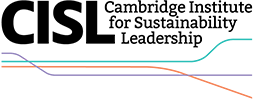
23 August 2022 - Dr Theo Hacking, CISL’s Director for Postgraduate Programmes and Research Strategy, reflects on the need for clarity in the use of systems thinking by sharing some of the common misconceptions that can lead to systems-related terms and concepts being misconstrued or devalued by false expectations.
It is now widely accepted that system thinking is needed to tackle complex, interconnected challenges – from the global pandemic to the climate crisis to social inequity.
Wherever sustainability is discussed, there is talk of ‘the system’ being broken, the need for systems change, and use of systems thinking. The challenge is that while it is easy to use such terms to express worthy aspirations, it is much harder to be clear about what they mean or what any individual or organisation can do as a result of ‘thinking about systems’. When the enthusiasm with which it is promoted outstrips its use in practice, there is the danger that it becomes little more than a catchphrase. It is also beginning to be subject to the Emperor's New Clothes phenomenon where it is risky to express confusion or misgivings out of fear of being considered poorly informed!
Systems thinking is a way of seeing and talking about reality in a manner that aims to better understand the interconnections between parts of a systems, and to synthesise this into a unified view of the whole. Its potential to provide this holistic understanding is the reason it has been recognised as a valuable tool to inform decision-making for sustainability. It potentially covers a very wide spectrum of approaches ranging from rigorous computer modelling to conceptual diagrams to ‘ways of thinking’. Prominent figures that have developed and promoted the use of systems approaches include Donella Meadows, lead author of The Limits to Growth, and Peter Senge, whose book The Fifth Discipline popularised its use in a business context.
The consequence of the lack of clarity around the use of systems thinking, is that some unhelpful misconceptions are beginning to manifest, which may result in systems-related terms and concepts being misconstrued or devalued by false expectations. In this primer I aim to develop insights that address some misconceptions that I have encountered. Here is a summary of the seven misconceptions that I cover in the article juxtaposed with insights that describe briefly a more appropriate understanding:
1. Systems are large-scale: The system thinker/analyst is free to define the boundaries of the system of interest, and this can range from process optimisation within a factory to interactions at a global scale, for example.
2. Systems change needs to be at a global level: The overall ambition is to achieve change at the global level; however large systems typically need to be changed by multiple actors within the ‘subsystems’ that make up a global system.
3. Systems thinking should replace reductionist approaches: They can be complementary – system thinking is appropriate for framing and understanding an issue, whereas reductionist approaches can be useful for more detailed analysis and action.
4. All system-level sustainability challenges are complex or ‘wicked’: The degree of complexity depends on the context, scale and/or level at which the problem is being addressed.
5. Intervention must be at a ‘deep’ systems level: A ‘deep’ motivation to act is of little use if it does not also result in practical and visible action; although the former is essential to ensure that the latter are substantive and well-directed.
6. System thinking is all about systems maps: There are a variety of other tools and approaches that are useful for supporting decisions in the face of complexity/uncertainty, e.g. scenario development; thereby informing our understanding of systems.
7. Only leverage points are needed to change systems: In addition to leverage points (Where?), to achieve systems change it is also necessary to define the system to be changed (What?), the ‘levers’ or interventions to be used (How?), and the execution pathway (When?).
Investigations for the article revealed a paucity of accessible examples where systems thinking has been used to inform interventions by individuals and organisations to address sustainability challenges and opportunities. This suggests that the rhetoric in support of systems thinking for this purpose is well ahead of its use in practice, and/or that further efforts are needed to capture examples that can be used to share experience.
CISL will not shy away from the challenges associated with achieving systems change at scale. It is stepping more boldly into this territory, and tackling these challenges is core to CISL’s postgraduate and other education programmes. Some innovative examples of systems approaches being used can be found amongst the dissertations submitted by our Master of Studies in Sustainability Leadership students, including to: identify the factors that impact the work of engineers striving for sustainability in an automotive manufacturer, investigate subjective wellbeing within a hotel business, design a local procurement strategy for a mining community, and explore how the impact of COVID-19 shifted paradigms to enable transformational future pathways for South Africa. These examples highlight a wide range of contexts and scales of application.
Much of the academic literature and work of the UN into changing global systems change, often linked to the attainment of the SDGs, has focused on action by governments and multilateral agencies, and has not paid much attention to the role of non-state actors. To engage a wider spectrum of actors and to realise the full potential of systems thinking/approaches in practice, areas requiring further investigation are:
- Defining more clearly the (global) systems that most urgently need to be transformed to achieve key sustainability outcomes, i.e. what needs to be changed.
- Identifying the ‘subsystems’ that that make-up the above systems, and the key actors that can influence or change them.
- Understanding the relationship between ‘bottom up’ versus ‘top down’ change driven by policymakers and global institutions, and the role of business in delivering the former and/or influencing the latter.
- More explicitly defining the leverage points, levers and pathways that can be pursued by individuals and organisations who are motivated to contribute to transform key (sub)systems.
- Capturing current examples of systems approaches being used to inform sustainability interventions.
Improved understanding in these areas will help to realise the full potential of systems thinking as an effective tool for informing decisions relating to sustainability interventions; thereby enabling its use in practice to mirror the enthusiasm with which it is use has been promoted.
In addition, it would be helpful to analyse historical examples of significant societal changes to determine the range of enabling factors and actors that were instrumental, with the view to applying these insights to current sustainability challenges. It could be insightful to analyse a wide spectrum of examples, such as: ending the transatlantic slave trade, ending apartheid, enfranchisement of women, reduction in smoking, shift to home working, shift to online shopping, CFC reductions, global climate agreements, rapid growth of renewables (in some countries), growth in electric vehicles, reduction in use of plastic shopping bags, and shift from single use plastics.
The spectrum of enabling factors for these changes might include various combinations and sequencing of: campaigning by individuals or groups; economic changes; demographic trends; war, conflict or violent protest; natural disasters or other unforeseen events; changing geopolitical landscape; shifts in public awareness, acceptance or preference; policy intervention or international agreements; scientific evidence or technological innovation; and/ or business action. Taking due cognisance of transferability, these insights could help to inform the design of interventions to achieve transformative change to address current challenges.
Misgivings around the state of the discourse and lack of accessible examples of systems change and systems thinking in practice is not to suggest that they are unimportant. CISL’s Rewiring the Economy promotes “change at the level of whole systems” and argues for this to be transformational and not merely focused on succeeding within current economic and social systems. This is rooted in the understanding that it will become increasingly untenable to conduct business against a backdrop of climate instability, resources scarcity, and social instability; hence there is no disputing that transformational change is needed and that systems thinkers will need to play a key role in determining the effective interventions needed to achieve this.
We are developing our resources on systems thinking and would like to hear from you. Please get in touch if you have examples of systems approaches being used to inform sustainability interventions here.





